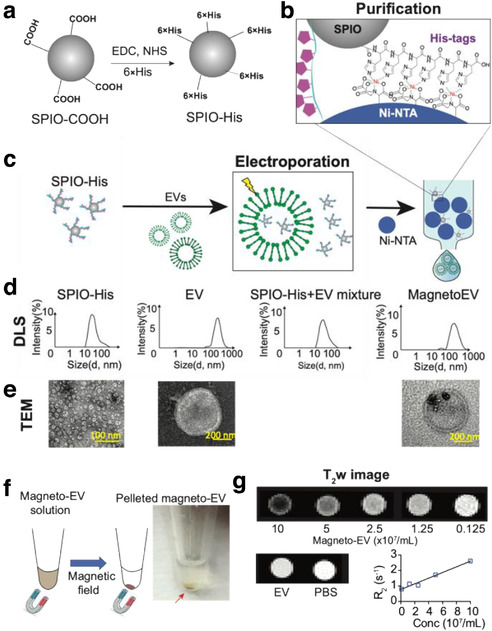FIGURE 1.

Preparation magneto‐EV and characterization of purified magneto‐EVs. (a) Schematic illustration of the preparation of SPIO his‐tag (SPIO‐His), by conjugating hexahistidine (6 × His‐tag) polypeptide to the carboxyl groups of SPIO particles using EDC (1‐ethyl‐3‐(3‐dimethylaminopropyl)‐carbodiimide), and NHS (sulfo‐N‐hydroxysuccinimide) chemistry. (b) As a result from the high affinity between the His‐peptide and nickel ion, the SPIO‐His particles bind to Ni2+ immobilized on beads (e.g. Ni‐NTA resins) for further purification. (c) Schematic illustration of the encapsulation of SPIO‐His into EVs by electroporation and subsequent purification by removing unencapsulated SPIO‐His from the elute using Ni‐NTA affinity chromatography. (d) Size distribution as measured by dynamic light scattering (DLS) for SPIO‐His, EVs, SPIO‐His/magneto‐EV/EV mixtures after electroporation, and the final purified elute, respectively. (e) TEM images of EV, SPIO‐His and EV‐SPIO, respectively. (f) Concentrating magneto‐EVs using a magnet. Eluted magneto‐EV solution was placed on a magnet overnight to pellet magneto‐EVs. The photograph shows the pelleted magneto‐EV at the bottom of a microcentrifuge tube. (g) T2‐weighted (T2w) images of magneto‐EVs at different concentrations, unlabelled EVs, and PBS. Mean R2 values of magneto‐EVs are plotted with respect to their concentration, from which the r2 (relaxivity) was estimated
